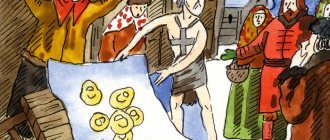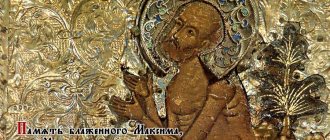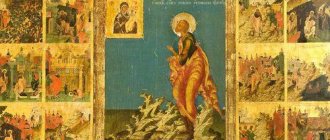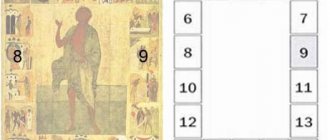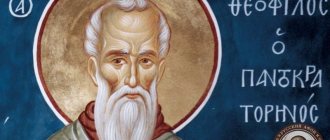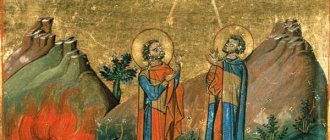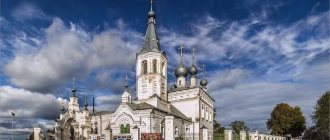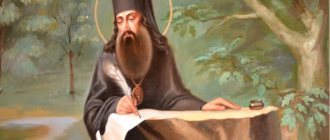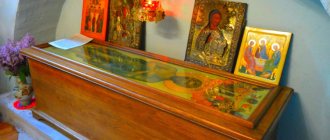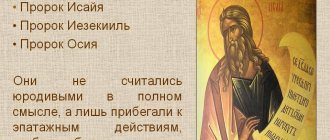Epiphany Cathedral in Yelokhov
Righteous Lawrence lived at the end of the 15th and beginning of the 16th centuries, under the appanage Kaluga prince Simeon Ioannovich. In Gorodishche, on the left bank of the Yacheyka River, half a mile from the present city of Kaluga, Prince Simeon Ioannovich ruled, who in 1505 received the Kaluga inheritance from his father.
From time to time, the servant of God, the holy fool Lawrence, lived in his house. In winter and summer, Lavrenty walked barefoot, wearing a shirt and a sheepskin coat. He lived in the prince's house only from time to time. Most of the time he prayed at the Church of the Nativity of Christ, where a monastery named after him was subsequently founded.
Here, half a mile from the city of his time, on the top of a mountain, then covered with dense forest, stood the secluded Church of the Nativity of Christ. Near the temple stood the hut of Blessed Lawrence. At night he came out of it onto the porch of the temple and performed prayers. And to listen to the daily prayers of the temple, a passage was dug into the ground from the hut to the temple and Lavrenty, invisible to people, went to the church to listen to her prayers.
Blessed Lawrence took an active part in the needs and sorrows of his fellow citizens and with his prayers saved them from the threatening danger.
The record of the Laurentian Monastery says:
– In the summer of 1512, the Crimean Tatars attacked the city of Kaluga, against whom Prince Simeon Ioannovich of Kaluga came out with a small army. Righteous Lawrence was at that time in the princely house and suddenly exclaimed: Give me my sharp axe, the dogs attacked Prince Simeon, so I can defend him from his dogs! And taking the ax he walked away. Prince Simeon, at that time, fought with the Hagarians from a ship on the Oka. To the Hagarians, who surrounded the prince in large numbers, the righteous Lawrence suddenly appeared at the settlement, strengthening him and encouraging the whole army, shouting: do not be afraid! And at that hour the Prince won and drove them away.
And the righteous Lawrence found himself again in the princely house, as if acting like a fool and saying: he defended Prince Simeon from the dogs. The prince, returning from the battle, told the story of how the righteous one appeared, and with his strengthening and help he defeated the enemies who had attacked the city of Kaluga. Thus, Kaluga owed its salvation from ruin, and the Prince owed the preservation of his life to the righteous Lawrence.
In 1515, on August 10, righteous Lawrence reposed and was buried in the Church of the Nativity of Christ.
The righteous prince Simeon Ioannovich, in gratitude for saving his life and for saving Kaluga from ruin, built a monastic monastery dedicated to his name, where the relics of Blessed Lawrence rested under a bushel, in the chapel of his name. In 1565, Tsar Ivan the Terrible wrote in his letter to the monastery: Monastery of the Nativity of Christ, where Lavrenty the Fool for Christ lies. From this it is clear that even then the righteous Lawrence was already locally revered.
To be continued.
THE FUCKING FOOLS. THE POWER OF THE SPIRITUAL MIND
TIME FOR SOAP BUBBLES
BURDEN OF USURES
BURDEN OF USURES. CONTINUATION
BURDEN OF USURES. CONTINUATION
BURDEN OF USURES. CONTINUATION
BURDEN OF USURES. CONTINUATION
TIME FOR BANKERS
PRE-ELECTION ODE
ORTHODOXY IN THE MODERN WORLD. ORTHODOXY AND POLITICS
FORGET ABOUT THE FUTURE. TEMPTATIONAL THOUGHTS
REMEMBER THE FUTURE
REMEMBER THE FUTURE
FORGET INTO OBLIGATION
WEB THREAD OF THE THIRD WORLD
LAVRENTY
Blzh. Lavrenty Kaluzhsky. Icon. 1st half XIX century (CAC MDA)
Blzh. Lavrenty Kaluzhsky. Icon. 1st half XIX century (TsAK MDA) († 10.08.1515 (?)), bl. (memorial August 10), Fool for Christ's sake, Kaluga. Little information about L. is provided by a brief introduction to the Miracles of the saint, known in manuscripts of the 17th-18th centuries. (RNB. Collection of Tikhanov. No. 751. Sheets 3-9, late 17th century; No. 274. Sheets 1-15, late 18th century; NSRK. Q. 5. Sheets 1-12 , 1756; TGOM. F. 1409. List 1. D. 150, last quarter of the 17th century; RSL. Music No. 9578, 2nd half of the 18th century; Music No. 10473. L. 15-24, late 17th - early 18th centuries; RSL. Tikhonr. No. 375. L. 288 v. - 289 v.; retelling of Miracles: RNL. NSRK. F. 107, 1860; Vlad. F. 8. L. 309 volume - 310, XIX century - EK IRLI. PD). The Kaluga Nativity Monastery kept a list compiled during the period of abbotship. Karion (1698-1722), in which there was an image of L. Found in literature (see: Leonid (Kavelin), 1888; Kovalevsky, 1895) the identification of the abbot of the Nativity Monastery with the priest. Karion (Istomin) is baseless, since the latter did not live in Kaluga during the indicated years. The dating of the last two miracles, 1666 and 1668, indicates that their composition was apparently completed long before the abbots. Karion (the Miracles of the time of his abbess are not recorded in the known lists). The composition of the texts is not the same: RSL lists. Music No. 9578, Music. No. 10473; RNB. Collection Tikhanov. No. 274 contains 9 miracles, including lifetime ones. On the lists of the National Library of Russia. Collection Tikhanov. No. 751 and TGOM (judging by the description of M.N. Speransky) - 5 miracles, the text ends with the Miracle of 1641 that happened to the townsman Trofim Ermolaev, and there are no Miracles about the healing of Andrei Kologrivov, the youth Simeon and Peter Kologrivov.
The introduction to Miracles says that L. lived at the court of the Kaluga prince. Semyon Ivanovich (appanage prince in 1505-1518). Perhaps the saint came from the noble family of Khitrovo, since his name was the first to be included in the synodikon of G.S. Khitrovo, kept in the Przemysl Trinity Lyutikov Monastery (Leonid (Kavelin). Historical description of the Przemysl Trinity Lyutikov Monastery. 1862 pp. 120-121). According to oral tradition, L. loved to pray in a cell connected by an underground passage to the church. in honor of the Nativity of Christ; remaining unnoticed, the holy fool often attended church services. In the 19th century the townspeople showed a bush, under the Crimea there was a descent into an underground passage (He. Historical description of the Kaluga Laurentian Monastery. 1862. No. 1. P. 4-5). In the preface to the Miracles, a detailed description of the saint’s appearance was preserved: “... the hair on the head has gray hair, long hair, disheveled, the brad is long, gray, forked at the end, you wear a fur coat, barefoot, in a suit” (RSL. Muz. No. 9578. L. 9-9 vol.).
The only miracle of the saint during his lifetime, dating back to 1512, tells about the salvation of the prince. Semyon Ivanovich in battle with the “Hagarians” (possibly with the army of the Crimean Khan Mengli-Girey). In the midst of the battle, when the prince, who was on the ship (“nasad”), was surrounded by the Tatars, the holy fool shouted in the princely chambers: “Give me my ax, the Agarian dogs attacked Prince Simeon.” With an ax in his hands, L. ran out of the house, after some time he returned and said to his family: “Defense from the dog of Prince Simeon!”
Reverends Tikhon of Kaluga and Paphnutius of Borovsky, Blessed. Lavrenty Kaluzhsky. Painting of the Kazan Church. Optina is empty. 2004 Master mon. Maria (Levestam)
Reverends Tikhon of Kaluga and Paphnutius of Borovsky, Blessed. Lavrenty Kaluzhsky. Painting of the Kazan Church. Optina is empty. 2004 Master mon. Maria (Levestam)
L. was buried under c. Nativity of Christ, after. here the Lavrentiy Kaluga monastery arose in honor of the Nativity of Christ (in the charter of Tsar Ivan IV Vasilyevich the Terrible (December 12, 1565) the “monastery of the Nativity of Christ, where Lavrentiy, the holy fool for Christ’s sake, lies) was mentioned.”
The date of the saint’s repose is called “The Book of the Verb Description of the Russian Saints”: “The holy righteous Lawrence, like Christ, for the sake of the holy fool, the miracle worker, reposed in the summer of 7023 (1515) of the month of August on the tenth day.” However, it was unknown to the compilers of Miracles, as indicated by the postscript in one of the lists: “... how long the saint lived and in what year he died is unknown, even if there was any kind of scripture, but before the invasion of the Hagarians and Polish and Lithuanian people there was no need to perish "(RGB. Music No. 9578. L. 9 vol.). The same date is found in the calendar with the chronicle: RSL. F. 651. No. 88. Sheet 800 vol., after 1719. Perhaps it arose from an incorrect reading of the only chronological indication of the Miracles: “the summer of 3K-g” (7020, i.e. 1512) was read as 3KG (i.e. 1515).
According to E.E. Golubinsky, L. was canonized in the 2nd half. XVI or 1st half. XVII century In an extract from the Kaluga scribe books of 1628 and 1629. scribe Grigory Pleshcheev and clerk Grigory Semyonov reported: “The Rozhestvennaya monastery is behind the settlement, where Lavrentey Christ for the sake of the ugly lies” (Simson P. Kaluga district during the time of Mikhail Feodorovich // Izv. Kaluga UAK. 1894. No. 3. P. 48). One of the first posthumous Miracles of the saint tells of the healing in 1621 at the relics of L. nobleman Andrei Kologrivov, whom his son Lev brought to the monastery. The paralyzed patient was carried into the church in his arms (“halfway”). When they began to sing a prayer service, he crossed himself, stood up and himself reached the saint’s shrine. In 1668, Lev Kologrivov again, “as promised,” visited the monastery. This time he brought his son Peter, who was obsessed with the “shaking disease.” After the prayer service and litiya, the son went home completely healthy (other representatives of this noble family also patronized the mon-ru; after the war of 1812, General A. S. Kologrivov donated trophy silver; it was kept in the bishop’s sacristy (Dneprovsky-Orbeliani. 2015 . P. 45)). The troparion and kontakion of St. Lawrence (see: Rudi. 2007. P. 469; in the list: RNL. Collection of Tikhanov. No. 751 their compilation is dated to May 4, 1666, in another list (Ibid. No. 274) the Miracle is dated at the same time about the healing of the youth Simeon, missing in manuscript No. 751). The saint is called a miracle worker in the inscription on the Gospel, enclosed in 1693 by Tsarevna Tatiana Mikhailovna in the Nativity Monastery in memory of the soul of her sister Anna (monastically Anfisa). In some lists of Miracles there is a service of L. (RGB. Music No. 10473. L. 9-15; on sheet 24 there is an entry: “This canon and miracles were written in the summer of 7203 (1695) on May 1 in the monastery The Nativity of Christ"; RSL. Music No. 9578. L. 1-8 vol.). Compiled in the 19th century. Akathists of Leningrad were not allowed for publication by spiritual censorship (definitions of the Synod of February 22, 1891 and May 22, 1894; see: Popov. Akathists. 1903. P. 437).
Memory of L. on August 10. included in the “Alphabet” of the Old Believer monastery. Jonah of Kerzhensky: “... Lavrenty died in the summer of 7023” (YaMZ. Inv. No. 15544, 1807-1811. L. 371).
L. was revered as the defender of the city. The Kaluga militia fought under a banner, on one side of which the Kaluga image of the Mother of God was depicted, on the other - L., in 1814 the banner was moved to the city’s cathedral (Anniversary collection in memory of the Patriotic War of 1812: 1812-1912 / Ed. . I. F. Tsvetkov. Kaluga, 1912. Color included between pp. 20 and 21; now the banner is kept in the Kaluga Museum of Local Lore (Tuminskaya. 2014. P. 39)).
L.'s relics were kept in the Nativity Cathedral under a bushel near the left choir; in 1750, a silver-plated copper shrine was built above them, on which was a life-size image of L. in a chased silver frame. In 1855, in connection with the renewal of the throne, the lower church of the Nativity Cathedral, consecrated in 1650 in the name of Archdeacon. sschmch. Lawrence, was renamed in the name of Blessed. Lavrenty Kaluga. Annually 10 Aug. In Kaluga there was a procession of the cross from the city to the monastery.
In 1918 the monastery was closed, in the 20s - early. 30s XX century destroyed the main buildings of the monastery. 6 Nov In 1993, on the site of the Nativity Cathedral above the supposed burial place of L., a cross with an unquenchable lamp was installed; in 1995, on the site of the altar, a wooden chapel was erected in the name of the blessed one. Lawrence. 15 Nov 2010 Metropolitan Kaluga and Borovsky Clement (Kapalin) laid the foundation for the cathedral in honor of the Nativity of Christ with chapels in the name of the blessed one. Lawrence and prmts. Elisaveta Feodorovna. As part of the celebration of the 500th anniversary of the death of the saint on December 28. In 2013, the Saint Laurentian local history readings were held in the monastery.
Source: Faithful Monthly. P. 27; Description about Russian saints. C. 231; Menaea (MP). Aug. Part 1. pp. 297-309.
Lit.: IRI. Part 6. pp. 1018-1020; Ratshin. Monasteries. P. 110; Leonid (Kavelin), archimandrite. East. description of the Kaluga Laurentian Monastery and the Krestovskaya Church belonging to it. // Kaluga EV. 1862. No. 1. P. 1-14; No. 2. P. 22-25; No. 6. P. 87 (department of publishing: Kaluga, 18882); aka. East. description of the Przemysl Trinity Lyutikov Monastery. Kaluga, 1862; aka. Review of handwritten and early printed books in the book depositories of the Kaluga diocese // CHOIDR. 1865. Book. 4. P. 5; aka. Holy Rus'. pp. 154-155; Muravyov. ZHSvRC. July. pp. 103-106; Barsukov. Sources of hagiography. Stb. 320-321; Filaret (Gumilevsky). RSv. T. 2. P. 477-480; Belyaev A., priest. Life and miracles of rights. Lawrence, Christ for the sake of the holy fool, Kaluga miracle worker. Kaluga, 1891; Speransky M. N. Description of the manuscripts of the Tver Museum. M., 1891. Issue. 1. pp. 213, 215, 216; Kovalevsky I., priest. Foolishness for Christ and for Christ's sake, holy fools Vost. and Rus. Churches. M., 1895. P. 251-255; Golubinsky. Canonization of saints. P. 153; Budovnits I.U. Dictionary Russian, Ukrainian, Belarusian. writing and literature until the 18th century. M., 1962. P. 298; Ivanov V.A. St. rights. Lavrenty Kaluga and the monastery named after him: (Some results and objectives of the study) // Mon-ry in the life of Russia. Kaluga; Borovsk, 1997. pp. 221-230; Romanova A. A. Miracles of Lavrenty Kaluga // SKKDR. Vol. 3. Part 4. pp. 238-240; Ivanov S. A. Blessed obscenities: The cultural history of foolishness. M., 2005. S. 261-262, 265; Rudi T.R. About the topic of the lives of holy fools // TODRL. St. Petersburg, 2007. T. 58. P. 457; Tuminskaya O. A. Handwritten lives of holy fools of the 16th-19th centuries: (According to the materials of the Russian National Library of Russia) // Bulletin of NArFU: Humanit. and social Sciences. Arkhangelsk, 2013. No. 1. P. 110-113; she is the same. The image of the holy fool in Christ in Russian. art con. XV - beginning XX century: ADD. St. Petersburg, 2014. P. 34, 39; Dneprovsky-Orbeliani A.S. Lavrentiev Monastery, which has shone throughout the centuries. Kaluga, 2015.
A. A. Romanova
Iconography
Blzh. Lavrenty Kaluzhsky. Icon. 3rd quarter XVII century (Ts. Martyr George, “what’s behind the horse”, Kaluga)
Blzh. Lavrenty Kaluzhsky. Icon. 3rd quarter XVII century (Central Martyr George, “What’s Behind”, Kaluga) The oldest known image of L. is in the Kaluga Cathedral Church. Vmch. George “what’s behind the horse” (1700-1701); V. G. Putsko dates it to the 3rd quarter. XVII century, but sees in it the features of mid-century painting (Pucko. 1993. S. 531-534. Il. 6). Perhaps this image (91×47) is a tombstone that appeared after the renovation of the shrine in the 50s. XVII century (stylistically close to the works of this time), or its repetition. According to archim. Leonid (Kavelin), in 1750, under Archimandrite. Cyprian, a forged silver frame was made for the tombstone (not preserved, the inscription on the frame: “This frame chasuble was built with the labor and diligence of the city of Kaluga merchants and other investors, in the summer of 1750, February 10, under Archimandrite Cyprian, renewed in 1786 "; the salary was updated later). What the ancient tombstone image looked like can be judged from the description of the frame: L. was presented full-length, probably frontally, with an unfolded scroll in his hand (Leonid (Kavelin). 1906. p. 45). This description in general terms corresponds to the translation of the icon from c. Vmch. George “what’s on horseback”, which shows a complete and iconographically complete image of L.: barefoot in a canvas shirt and ports, in an open sheepskin coat thrown over his shoulders, in his left hand he has an unfolded scroll and an axe, his right hand is pressed to his chest in a prayerful gesture. Light thick hair is raised in separate strands, the beard is long, chest-length. The ground depicts a desert area with trees. An image of the Savior Not Made by Hands is placed above the saint’s head (perhaps as a reminder of the image located above the tomb). On the top field there is the inscription: “Holy righteous Christ for the sake of the holy fool Lawrence.” Text on the scroll: “By the mercy of God and the prayers of this holy righteous Christ, for the sake of the Foolish Lawrence, we helped the Grand Duke Semyon Ioannovich of Kaluga, and before us, the prince appeared in the house to announce victory.”
This iconographic version of L.’s image was not only reproduced several times, but was also included as a description of the saint’s appearance in the iconographic original: “Like russian hair, debts, disheveled, long hair, forked at the end. I wear a fur coat and go barefoot in a suitcase” (Filimonov. Iconographic original. P. 66). In the same original, a second version of the image of the saint is mentioned: naked, with a fur coat thrown over his shoulders, but the icons of this version are unknown: “Sed, like Vlasiev’s brada, forked at the end, at the head of the plate, completely naked, fur coat on his shoulders” (There same). Likening sshmch. Blaise of Sevastia is found in the Strogonov explanatory icon-painting original (late 18th century) with the addition of “all naked”, “in the ports” to the description; it also indicates “the right hand is a prayer service, in the left there is a tapor” (BAN. Strict. No. 66. L. 135; the same with the addition of “on the head of the plates” in the RKP. BAN. Strict. No. 64. L. 137 vol.).
Blzh. Lavrenty Kaluzhsky. Engraving. 1892
Blzh. Lavrenty Kaluzhsky. Engraving. 1892
In the 18th century the nature of L.'s image (clothes and type of face) did not change, but the frontal images of the saint, as on the icon in c. Vmch. George's "what's behind" are no longer found. In a 3/4 turn in prayer to the Savior, L. is presented on the right field of the Kazan Icon of the Mother of God, painted in Kaluga by Roman Rodionov (1703, State Historical Museum; signature: “Holy Fool Lawrence of Koluga”; on the left field is the image of St. Tikhon of Yaroslavl ). In the wall painting of the Kaluga Church of the Great Martyr. George “What’s Behind the Horse”, made in 1766-1767, the image of L. is placed on the slope of the north window. walls of the temple, on the opposite slope - book. Semyon Kaluzhsky.
By 1st half. XIX century Changes appear in the iconography of the saint caused by the veneration of L. not only as a blessed one, but also as the founder of the Laurentian Kaluga monastery in honor of the Ascension of the Lord. So, on the icon from the Tikhvin chapel c. St. St. Nicholas the Wonderworker on Kozinka in Kaluga (late 18th century). L. is depicted next to the mon-rem; shows the buildings of the monastery after reconstruction in 1790 (110×58 cm; Putsko. 1993. S. 536. Il. 7). In the hands of the saint is a scroll, on which the inscription is reproduced, known from the ancient icon of L. from c. Vmch. George "what's behind the horse." A similar image is presented on the icon of the con. XIX century from c. St. St. Nicholas the Wonderworker on Kozinka (13.6×11.2 cm; framed; see: Ibid. Il. 9).
On some icons the 2nd floor. XIX century L.'s image has lost the characteristic features of iconography: instead of a fur coat, he is wearing a monk's robe, and around his neck is a white scarf tied in a knot. This is how L. is depicted on the mentioned icon. XIX century from c. St. St. Nicholas the Wonderworker on Kozinka. On the icon “Saints Lawrence and Tikhon of Kaluga in prayer to the Most Holy. Mother of God of Kaluga" (19th century, KHM) and on the field of the icon "The Ascension of the Lord" by the Moscow master A. S. Rogozhkin (painted by order of the Kaluga city council in 1870; KHM) the composition of clothes and the position of L.'s hands change: he is depicted without attributes , arms folded crosswise on the chest. On a number of icons L. is represented as St. Artemy Verkolsky, in white trousers and a shirt, with an ax on his shoulders, without a fur coat and robe (Putsko. 1993. S. 536. Il. 8).
At the same time, images of the saint are preserved, adhering to the ancient model. These include the 1st floor icon. XIX century (TsAK MDA), in which the saint is presented in a desert area, on the bank of a river, wearing a fur coat thrown over his shoulders, with an ax in his hands. The icon is small (24.4x20.2 cm) and probably belongs to monastic images intended for offerings and blessings. On the back there is an inscription: “God’s blessing // to the most venerable Praskovya // Karpovna Kologriva with wishes and prayers for her prosperity // and long life // Nikolai Bishop of Kaluga // and Borovsky. // ...year // ...on the 23rd day.” P.K. Kologrivova, who came from a boyar family, whose representative received healing at the tomb of the miracle worker, was probably one of the regular donors of the monastery (Nechaeva. 2004. P. 188. Ill. on p. 189).
XIX century the one-of-a-kind icon “Saints Tikhon and Lawrence of Kaluga, Paphnutius Borovsky with the Trinity and scenes of miracles at the relics of Lawrence” (KMRI) is dated with a unique composition of marks of posthumous miracles of L., known from the monastery manuscript (Leonid (Kavelin). 1865. P. 5). L. is presented in the middle of the icon, in the traditional. form - in ports and fur coats. Composition of the stamps: 1. Deliverance of the city of Kaluga from the invasion of the Hagarians. 2. Old Testament Trinity. 3. Healing of the relaxed boyar Andrei Kologrivov. 4. Healing the demoniac. 5. Healing of a blind wife. 6. Healing of a young man from a leg disease. 7. Healing of a blind girl. 8. Healing of the possessed. 9. Healing of L. A. Kologrivov’s son Peter. 10. Healing from shaking disease. On the back there is an inscription: “Blessing of the Kaluga mayor May 10, 1887.”
“The miracle of the salvation of Kaluga” became a separate subject for a number of monuments. It was placed on the saint’s shrine (Leonid (Kavelin). 1906. P. 46). An expanded version of the composition with an explanatory inscription is presented on the icon. XVIII - beginning XIX century (KHM; 44×75.5 cm; Putsko. 1993. Il. 10), shortened - in the mark of the mentioned icon with scenes of posthumous miracles (KMRI).
L.'s image was placed on the reverse side of the banner of the Kaluga militia of 1812. The Kaluga miracle worker was represented as “listening to the voice of heaven” (Efimenkova. 2009. P. 229).
Archimandrite's book Leonid (Kavelin) “Historical Description of the Kaluga Laurentian Monastery” (1891) is illustrated with an engraving depicting L. (ill. between pp. 16 and 17). The saint is presented in an unusual way: praying in the forest, his beard is short and scraggly, he is barefoot, wearing a sheepskin coat or an overcoat, wrapped and belted, with an ax lying nearby. With a high degree of probability it can be assumed that this engraving reproduces the image on a miniature of the 18th century. from the handwritten Tale of the Miracles of L. (Archim. Leonid saw this image, but did not leave its description).
Lit.: Leonid (Kavelin), archimandrite. East. description of the Przemysl Trinity Lyutikov Monastery. Kaluga, 1862; aka. Review of handwritten and early printed books in the book depositories of the Kaluga diocese // CHOIDR. 1865. Book. 4. P. 5; aka. East. description of the Kaluga Laurentian Monastery, the current Kaluga bishop's house and the Krestovskaya Church belonging to it. Kaluga, 1891, 1906p; Filimonov. Iconographic original; Tokmakov I. F. Sat. ist. materials for compiling chronicles of the Kaluga bishop. Kaluga, 1889; Zverinsky. 1890. T. 1; Sergius (Spassky). Monthsword. T. 2. P. 210; Malinin I. D. Experience of history. travel in Kaluga. Kaluga, 1992; Putsko V. G. Icons with images of Kaluga saints // Tausend Jahre Taufe Russlands: Russland in Europa. Lpz., 1993. S. 528-538. Il. 6-10; Markelov. Saints Dr. Rus'. T. 2. P. 152; Nechaeva T. N. Blessed Lavrenty of Kaluga // “This work is acceptable in the sight of God...”: Treasures of the Central Accreditation Committee of the MDA. Serg. P., 2004. P. 188. Ill. us. 189; Filaret (Gumilevsky). RSv. 2008 M., pp. 441-442; Efimenkova M.A. Fools for Christ’s sake in the spiritual life of the Kaluga region // Kaluga in the 6th centuries: Materials of the 7th city local historian. conf. 2008 Kaluga, 2009. pp. 226-233.
T. N. Nechaeva
Kaluga St. Lawrence Monastery and St. Righteous Lawrence
The Kaluga St. Lawrence Monastery was founded in 1515, when Kaluga was an independent principality, given by the Grand Duke of Moscow John III as an inheritance to his fourth son, Prince Simeon of Kaluga (1487-1518). This is the oldest monastery in the city of Kaluga and the entire Kaluga land.
The monastery is dedicated to the Holy Righteous Lawrence of Kaluga (? -08/10/1515), whom the pious Prince Simeon sheltered in his house. Having taken upon himself the feat of Christ for the sake of the holy fool, blessed Lawrence loved to pray in solitude half a mile from the city of Kaluga, on a high hill, not far from a lonely church in the name of the Nativity of Christ. There, according to legend, he built himself a hut to carry out the feat of foolishness, fasting and prayer. “On ancient icons kept in churches and houses of the Kaluga region, the Righteous Lawrence is reverently depicted barefoot, as he walked winter and summer, in a shirt, ports and sheepskin, with an ax mounted on a long shaft...” So why is he holding an ax in his hands?
Saint Lawrence was and remains the prayerful protector of the Kaluga land. When the Tatars attacked the city of Kaluga in 1512, he saw this with his spiritual gaze, shouted, demanded an ax, took it and rushed to the battlefield to defend Prince Simeon and the Russian army, not so much with his terrifying appearance, but with prayer and a fearless call: “Do not be afraid.” ! And then the course of the battle, already almost lost by the Russians, changed. The Tatars were defeated. Since then, both the authorities and the city of Kaluga have revered St. Lawrence as their savior. And in 1515, after the repose of Righteous Lawrence, he was buried with honors “... in his beloved Church of the Nativity of Christ, where to this day they rest under the cover of his Holy relics, exuding healing to all who come with faith.”
Blessed Lavrenty of Kaluga, Fool for Christ's sake
Brief life of Blessed Lawrence of Kaluga
Blessed Lawrence, the Fool for Christ's sake, the Kaluga miracle worker, lived at the beginning of the 16th century half a mile from old Kaluga at a forest temple in honor of the Nativity of Christ, which stood at the top of the mountain.
An underground passage was dug from his hut to the church, where he listened to the service. He also visited the house of the Kaluga prince Simeon Ioannovich. It is believed that Blessed Lawrence came from the boyar family of the Khitrovs, because their family memorial in the Przemysl Lyutikov Monastery, located in the Kaluga diocese, began with his name. In winter and summer, the blessed one walked barefoot, wearing a shirt and a sheepskin coat. Through exploits of self-denial, he rose to the point that even during his lifetime he became famous for his grace-filled gifts.
When the Crimean Tatars attacked Kaluga in May 1512, Blessed Lawrence, who was in the prince’s house, suddenly shouted in a loud voice: “Give me my sharp axe, the dogs attacked Prince Simeon, we must defend him!” Having said this, he grabbed the ax and left. Suddenly finding himself on a nasad (ship) next to the prince, righteous Lawrence strengthened and encouraged the soldiers, and they immediately defeated the enemy. With an ax in his left hand, impaled on a long ax handle, he is depicted on icons. It is likely that Prince Simeon († 1518), who owed his salvation to the righteous man, built a monastic monastery in his memory on the site of the saint’s exploits.
Blessed Lawrence died on August 10, 1515, apparently on the day of his namesake. It is known that the memory of the saint was also honored on July 8th.
Blessed Lawrence was glorified, apparently, in the second half of the 16th century. Thus, Tsar Ivan the Terrible, in a letter to the monastery (1565), wrote: “The Monastery of the Nativity of Christ, where Lavrenty, the holy fool for Christ’s sake, lies.” In the life, the first posthumous miracle is recorded in 1621 - the healing of the paralyzed boyar Kologrivov, who recovered after performing a prayer service to the saint.
Complete Life of Blessed Lawrence of Kaluga
Blessed Lavrentiy, Fool for Christ's sake, Kaluga begins the ancient family synodikon (memorial) of the boyar family of the Khitrovs, located in the Przemysl Lyutikov Monastery of the Kaluga diocese. This, like other indirect evidence, suggests that Blessed Lawrence came from an old family.
In 1505, Kaluga, located 190 km southwest of Moscow, became an independent principality, bequeathed by John III (1462–1505) as an inheritance to his son Simeon (1505–1518).
Blessed Lavrentiy lived from time to time in the house of this Kaluga prince. The main miracle of the saint is also associated with the name of Simeon Ioannovich. The chronicle says about the life of the prince himself: “In the summer of 6995 (1487) March, on the 21st day, at 7 o’clock in the afternoon, Grand Duke Ivan Vasilyevich’s son Simeon was born.” And after 25 years, he, already the Kaluga ruler, “wanted to flee to Lithuania from his brother, Grand Duke Vasily Ioannovich of All Rus', and the great prince, knowing this, sent an ambassador to him and ordered him to be with him, and wanted to lay his disgrace on him; Prince Semyon Ivanovich, for his guilt, began to beat the sovereign great prince with his forehead, and the great prince granted him the sadness of Simon, Metropolitan of All Rus' and his brethren and rulers, and gave him the guilt; and his people, the boyars and the boyars’ children, changed everyone.”
Two years later, Simeon Ioannovich already participated in the campaign undertaken by the Grand Duke to return Smolensk from the Poles: “1514 of the same summer, June 8, the Great Prince Vasily Ivanovich of All Rus' went from Moscow to the third army (third campaign) to the city of Smolensk, and with him are his brothers Prince Yuri and Prince Semyon Ivanovich; (...) and I took Smolensk.”
The fact that the brothers finally reconciled is confirmed by the following entry of the chronicler: “1518. That same spring, May, the Great Prince Vasily Ivanovich, Sovereign of All Rus', was in his estate on Volots on Lamsky, and with him his younger brothers, Prince Semyon Ivanovich and Prince Ondrei Ivanovich, for their amusement.”
But this was the last news about the Kaluga prince. He died on June 26, 1518.
In later testimonies, Prince Simeon appears as a kind, caring ruler, honored to do good to the holy man and, in turn, receive miraculous help from him for himself and the entire city. The Kaluga Chronicle notes: “In 1512, the Agarians (Crimean Tatars) attacked the city; The prince (Simeon) and the citizens came out against them, and the righteous Lawrence, who was in his house, suddenly shouted in a loud voice: “Give me a sharp axe, the dogs attacked Prince Simeon, we must defend him from the dogs”; and grabbed (the ax) and left. And when Prince Simeon was fighting from a nasad (ship) on the Oka, and the Hagarians surrounded the prince in large numbers, righteous Lawrence suddenly appeared on the nasad, strengthening him and the entire army with the words: “Do not be afraid.” At that same hour the prince defeated the Hagarians and drove them away; and the righteous Lawrence again appeared in the prince’s house and, acting like a fool, made a noise: “Defended the prince from the dogs.” The prince, returning from the battle, told how the righteous man appeared and with his help the enemies who attacked Kaluga were defeated.”
Saint Lawrence is also depicted on ancient icons with an ax mounted on a long ax handle. He walked barefoot in winter and summer, wearing a shirt and a sheepskin coat. He lived in the prince's house only for some time, and more - where a monastery named after him was subsequently founded. Here, half a mile from the city of his time (now a settlement on the left bank of the Yachenka River), on the top of a mountain covered with dense forest, stood the secluded Church of the Nativity of Christ; Near the temple there was the hut of Blessed Lawrence. At night he went out of it onto the porch of the temple and said prayers, and to listen to the divine service, a passage was dug from his hut in the ground, and the righteous Lawrence went to the church, hiding his prayers from people. Through his exploits of self-denial he became so elevated in spirit that during his lifetime he became famous for the miracle of his defense of Kaluga. The handwritten calendar says: “The Holy Righteous Lawrence, like the Fool for Christ’s sake, the miracle worker, reposed in the summer of 7023 (1515) in the month of August on the tenth day.” On the site of his exploits, probably by Prince Simeon, a monastery was built. The relics of the righteous Lawrence rested under a bushel near the left choir. In 1565, Ivan the Terrible wrote in a letter to the monastery: “The Monastery of the Nativity of Christ, where Lavrenty the Fool for Christ lies.” From this it is clear that in the 16th century the memory of the righteous Lawrence was already honored. The monastery kept the Gospel of 1686 with the caption: “Tsarevna Tatiana Mikhailovna granted St. Lawrence the Wonderworker to the monastery.” The pious sister of Tsar Alexei Mikhailovich is also known for being a supporter of the reforms of His Holiness Patriarch Nikon († 1681). The monastery had 3 churches, a bell tower, abbots' and brethren's cells, and around the monastery there was a stone wall with towers.
Posthumous miracles of the righteous Lawrence
The description of the posthumous miracles of the righteous Lawrence is known from the list compiled in the monastery under Abbot Karion (abbot-abbot from 1697, archimandrite from 1708; (1722)). Hieromonk Karion (Istomin) was a zealous assistant to Patriarch Adrian.
The first of the miracles dates back to 1621. This is the healing of the paralyzed boyar Lev Andreevich Kologrivov. He had no control over his arms, legs, or tongue. They brought him and laid him near the tomb of St. Lawrence. During the singing of the prayer service, when the Gospel was being read, the paralytic spoke, raised his right hand and began to make the sign of the cross on himself; then he stood up, went to the tomb and kissed it. At the end of the prayer service, he spoke freely and became completely healthy, as before.
On June 1, 1622, the righteous Lavrenty healed the demoniac resident of Kaluga, Stefan. One day, Stephen’s relatives took Stefan to the monastery to pray to the righteous Lawrence, but the possessed man, frightened by evil spirits in the form of fierce beasts rushing to tear him to pieces, resisted. Near the Church of the Epiphany, the holy fool Lawrence suddenly appeared to Stephen for Christ's sake, drove away the evil demons from him and ordered him to go to the monastery of the Nativity of Christ, to his tomb. The sufferer fulfilled the command of the saint of God, came, venerated the coffin, and at the end of the prayer service returned to his home healthy.
In 1632, at the tomb of Blessed Lawrence, another demoniac was healed. He was so severely tormented by a demon that during his three-day stay in the monastery he frightened all the monks. But on the 4th day during the service, during the singing of the Cherubic Song, the sufferer received complete deliverance from demonic torment.
Through the prayers of Blessed Lawrence of Kaluga, healings of eye diseases were carried out.
There were numerous healings from other ailments, which at that time were called by one common name - fever.
The Kaluga miracle worker was also an assistant in military affairs. The saint, who defended Kaluga during his lifetime, and after his blessed death, sent abundant aid to the Russian army and delivered the state from enemies who came to conquer Kaluga and found death here.
During the Napoleonic invasion, Blessed Lawrence’s intercession for his native land was especially pronounced. Kaluga places became “the limit of the offensive and the beginning of the retreat and death of the enemy,” as it is written on the Maloyaroslavets monument in honor of the battle of October 12, 1812.
When, after the battle of Maloyaroslavets on October 12, 1812, the enemy began to retreat, the Kaluga residents saw in this the mercy of God, the intercession of the Mother of God in Her miraculous Kaluga image and the help of the patron saint of the city - Blessed Lawrence. The Holy Synod, by decree of June 17, 1813, granted the request of citizens to leave the image of Blessed Lawrence in the cathedral and decided to carry out an annual religious procession around Kaluga with it in memory of the miraculous intercession on October 12, 1812.
It is known that during the Patriotic War of 1812, the Kaluga militia was assembled - 15,000 people. After the prayer service, Bishop Evlampy (Vvedensky) of Kaluga led everyone to the oath and spoke to them a word imbued with deep hope for God’s help. Having sprinkled the militia with holy water, he presented the head of the militia, Lieutenant General Shepelev, with a banner, on which on one side was the image of the Kaluga Mother of God, and on the other - the holy righteous Lawrence. The militia, which included local seminarians, marched under this banner throughout the war. And after the victorious return of troops from a foreign campaign, it was placed in the Kaluga Cathedral in 1814.
In addition to August 10, the day of the repose of Blessed Lawrence, the saint’s memory was also honored on July 8, probably in memory of the first miraculous healing in Kaluga, which boyar L.A. received. Kologrivov in 1721.
Orthodox prayer - Orthodox book
What do people pray to Blessed Lawrence of Kaluga for?
Saint Lawrence of Kaluga came from the boyar family of Khitrovo and lived in the 15th – early 16th centuries. not far from Kaluga. It is believed that he was a monk who carried out the feat of foolishness for Christ's sake. He labored in solitude, building himself a hut next to the church in the name of the Nativity of the Blessed Virgin Mary, half a mile from the city, on a wooded mountain. At night the saint prayed on this mountain, and during the day, invisible to people, he came through an underground passage to one of the churches of Kaluga. The holy fool died on August 10, 1515. Many cases of healings were recorded through the prayers of believers at his holy relics, especially from paralysis, demonic possession, eye diseases, and fever. Blessed Lawrence repeatedly provided assistance to Russian soldiers who defended the Kaluga lands from enemies, especially during the Patriotic War of 1812. Therefore, they specifically pray to him for the healing of those suffering from physical and mental ailments, as well as for deliverance from attacks by external enemies; he is revered as the patron saint of Kaluga. The Kaluga miracle worker is also asked to intercede with the Lord for those who pray sincere repentance and salvation of the soul, fertility of the earth, favorable weather conditions, help in good deeds, peaceful and pious life, consolation for the grieving and despondent, protection for the orphans and the poor, and for the dying - a good Christian death.
Prayer to Blessed Lawrence of Kaluga, Fool for Christ's sake
O holy and God-glorified righteous and miracle worker Lavrentie, quick helper and zealous intercessor of all who come to you in prayer with faith and love! Behold, we, humility and sinners, burdened with the heavy burden of many of our iniquities, in deep tenderness we resort to you, and fall upon the multi-purpose healing of your holy relics , we pray and ask you: pray for us to the Lord God, that He may not destroy us with our iniquities, but turn us to the path of repentance and salvation. We are powerful, we are powerful, for the prayer of the righteous can accomplish much before Him. We offer you, a truly righteous being, to pray to Him with strong trust, as for your sake of heavenly representation before Him, we, the unworthy ones, will have mercy. Ask us from our Creator for the great and rich gifts of His goodness: fruitfulness of the earth, goodness of the air, good season rains, peace in our days, increase of piety, to those who are sick health, comfort to those who mourn, encouragement to those who are despondent, charity to those who are orphaned, provision to those in need, prosperity to those who strive, a good Christian death to those who die, and eternal salvation to all who believe in the law. . I will keep your city and your holy abode in peace and order, as their unyielding guardian and guardian. Hey, servant of God! Do not disgrace our hope, but show us your holy intercession, so that we magnify you silently, as our great representative, and glorify the ineffable love of humanity in our saints The Triune God, the Father and the Son and the Holy Spirit forever and ever. Amen.
© Mikhail Tikhomirov Quoted in abbreviation from the book: PRAYERS TO THE SAINTS OF GOD WITH BRIEF INFORMATION ABOUT LIVES AND HELP FOR DIFFERENT NEEDS. – M.: Publishing house. Tikhomirova M.Yu., 2022 (the book is being prepared for publication).
▪ Orthodox book by mail pravmolitva.ru
Memorial Days:
August 10 (23)
the well-established Lavrentiy, the holy fool for Christ's sake, Kaluga begins the ancient family synodik (memorial) of the boyar family of the Khitrovs, located in the Przemysl Lyutikov Monastery of the Kaluga diocese. This, like other indirect evidence, suggests that Blessed Lawrence came from an old family.
In 1505, Kaluga, located 190 km southwest of Moscow, became an independent principality, bequeathed by John III (1462-1505) as an inheritance to his son Simeon (1505-1518).
Blessed Lavrentiy lived from time to time in The main miracle of the saint is also associated with the name of Simeon Ioannovich. The chronicle says about the life of the prince himself: “In the summer of 6995 (1487) March, on the 21st day, at 7 o’clock in the afternoon, Grand Duke Ivan Vasilyevich’s son Simeon was born.” And after 25 years, he, already the Kaluga ruler, “wanted to flee to Lithuania from his brother, Grand Duke Vasily Ioannovich of All Rus', and the great prince, knowing this, sent an ambassador to him and ordered him to be with him, and wanted to lay his disgrace on him; Prince Semyon Ivanovich, for his guilt, began to beat the sovereign great prince with his forehead, and the great prince granted him the sadness of Simon, Metropolitan of All Rus' and his brethren and rulers, and gave him the guilt; and his people, the boyars and the boyars’ children, changed everyone.”
later , Simeon Ivanovich already participated in the campaign undertaken by the Grand Duke to return Smolensk from the Poles: “1514 of the same summer, June 8, Grand Duke Vasily Ivanovich of All Russia went from Moscow to the third army (third campaign) to the city of Smolensk, and with him his brothers Prince Yuri and Prince Semyon Ivanovich; (...) and I took Smolensk.”
The fact that the brothers finally reconciled is confirmed by the following chronicler’s entry: “1518. That same spring, May, the Great Prince Vasily Ivanovich, Sovereign of All Rus', was in his estate on Volots on Lamsky, and with him his younger brothers, Prince Semyon Ivanovich and Prince Ondrei Ivanovich, for their amusement.”
But this was the last news about the Kaluga prince. He died on June 26, 1518.
In later testimonies, Prince Simeon appears as a kind, caring ruler, honored to do good to the holy man and, in turn, receive miraculous help from him for himself and the entire city. Kaluga Chronicle about; and grabbed (the ax) and left. And when Prince Simeon was fighting from a nasad (ship) on the Oka, and the Hagarians surrounded the prince in large numbers, righteous Lawrence suddenly appeared on the nasad, strengthening him and the entire army with the words: “Do not be afraid.” At that same hour the prince defeated the Hagarians and drove them away; and the righteous Lawrence again appeared in the prince’s house and, acting like a fool, made a noise: “Defended the prince from the dogs.” The prince, returning from the battle, told how the righteous man appeared and with his help the enemies who attacked Kaluga were defeated.
Saint Lawrence is also depicted on ancient icons with an ax mounted on a long ax handle . He walked barefoot in winter and summer, wearing a shirt and a sheepskin coat. He lived in the prince's house only for some time, and more - where a monastery named after him was subsequently founded. Here, half a mile from the city of his time (now a settlement on the left bank of the Yachenka River), on the top of a mountain covered with dense forest, stood the secluded Church of the Nativity of Christ; Near the temple there was the hut of Blessed Lawrence. At night he went out of it onto the porch of the church and said prayers, and to listen to the Divine service, a passage was dug from his hut in the ground, and the righteous Lawrence went to the church, hiding his prayers from people. Through his exploits of self-denial he became so elevated in spirit that during his lifetime he became famous for the miracle of his defense of Kaluga. The handwritten calendar says: “The Holy Righteous Lawrence, like the Fool for Christ’s sake, the miracle worker, reposed in the summer of 7023 (1515) in the month of August on the tenth day.” On the site of his exploits, probably by Prince Simeon, a monastery was built. The relics of the righteous Lawrence rested under a bushel near the left choir. In 1565, Ivan the Terrible wrote in a letter to the monastery: “The Monastery of the Nativity of Christ, where Lavrenty the Fool for Christ lies.” From this it is clear that in the 16th century the memory of the righteous Lawrence was already honored. The monastery kept the Gospel of 1686 with the caption: “Tsarevna Tatiana Mikhailovna granted St. Lawrence the Wonderworker to the monastery.” The pious sister of Tsar Alexei Mikhailovich is also known for being a supporter of the reforms of His Holiness Patriarch Nikon (+ 1681). The monastery had 3 churches, a bell tower, abbots' and brethren's cells, and around the monastery there was a stone wall with towers.
The record of posthumous miracles of the righteous Lawrence is known from the list compiled in the monastery under Abbot Karion (abbot-rector from 1697, archimandrite from 1708; (1722). Hieromonk Karion Istomin was a zealous assistant to Patriarch Adrian.
The first of the miracles dates back to 1621. This is the healing of the paralyzed boyar Lev Andreevich Kologrivov. He had no control over his arms, legs, or tongue. They brought him and laid him near the tomb of St. Lawrence. During the singing of the prayer service, when the Gospel was being read, the paralytic spoke, raised his right hand and began to make the sign of the cross on himself; then he stood up, went to the tomb and kissed it. At the end of the prayer service, he spoke freely and became completely healthy, as before.
1 On June 1622, the righteous Lavrenty healed the demoniac resident of Kaluga, Stefan. One day, Stephen’s relatives took Stefan to the monastery to pray to the righteous Lawrence, but the possessed man, frightened by evil spirits in the form of fierce beasts rushing to tear him to pieces, resisted. Near the Church of the Epiphany, the holy fool Lawrence suddenly appeared to Stephen for Christ's sake, drove away the evil demons from him and ordered him to go to the monastery of the Nativity of Christ, to his tomb. The sufferer fulfilled the command of the saint of God, came, venerated the coffin, and at the end of the prayer service returned to his home healthy.
In 1632, at the tomb of Blessed Lawrence, another demoniac was healed. He was so severely tormented by a demon that during his three-day stay in the monastery he frightened all the monks. But on the 4th day, during the Divine Service, during the singing of the Cherubic Song, the sufferer received complete deliverance from demonic torment.
Through the prayers of Blessed Lawrence of Kaluga, healings of eye diseases were performed.
also numerous healings from other ailments, which at that time were called by one common name - fever.
The Aluga miracle worker was also an assistant in military matters. The saint, who defended Kaluga during his lifetime, and after his blessed death, sent abundant aid to the Russian army and delivered the state from enemies who came to conquer Kaluga and found death here.
During the Napoleonic invasion, Blessed Lawrence’s intercession for his native land was especially pronounced. Kaluga places became “the limit of the offensive and the beginning of the enemy’s retreat and death,” as it is written on the Maloyaroslavets monument in honor of the battle of October 12, 1812.
When, after the battle of Maloyaroslavets on October 12, 1812, the enemy began to retreat, the Kaluga residents saw in this the mercy of God, the intercession of the Mother of God in Her miraculous Kaluga image and the help of the patron saint of the city - Blessed Lawrence. The Holy Synod, by decree of June 17, 1813, granted the request of citizens to leave the image of Blessed Lawrence in the cathedral and decided to carry out an annual religious procession around Kaluga with it in memory of the miraculous intercession on October 12, 1812.
And it is known that during the Patriotic War of 1812, the Kaluga militia of 15,000 people was assembled. After the prayer service, Bishop Evlampy (Vvedensky) of Kaluga led everyone to the oath and spoke to them a word imbued with deep hope for God’s help. Having sprinkled the militia with holy water, he handed the head of the militia, Lieutenant General Shepelev, a banner, on which on one side was the image of the Kaluga Mother of God, and on the other - the holy righteous Lawrence. The militia, which included local seminarians, marched under this banner throughout the war. And after the victorious return of troops from a foreign campaign, it was placed in the Kaluga Cathedral in 1814.
On August 10, the day of the repose of Blessed Lawrence, the saint’s memory was also honored on July 8, probably in memory of the first miraculous healing in Kaluga, which the boyar L. A. Kologrivov received in 1721.
Blessed Lawrence, fool for Christ's sake. Tro par
voice 4
Enlightened by divine grace, O God-Wise One,/ and having unswervingly placed all your mind and heart from this vanity world/ to the Creator,/ with chastity and much patience in your temporary life, you ended the course of goodness/ and you kept your faith immaculate./ Likewise, even after death, the lordship of life appeared yours, / having flowed forth with miracles an inexhaustible source / by faith flowing to your holy tomb, all-blessed Lawrence, / pray to Christ God that he may save our souls.
Blessed Lawrence, fool for Christ's sake. Troparion
voice 3
With holy righteous Lawrence,/ pray to the Merciful God/ to grant forgiveness of sins/ to our souls.
Kontakion of Blessed Lawrence
voice 8
And to the chosen and wondrous among the righteous, / who has received the gift of miracles from Christ, / now we bring praiseworthy verbs, / but as if we have boldness towards the Holy Trinity, / You pray to be delivered from troubles by your servant, and we call you: / Rejoice, God-Wise Lawrence.
Prayer to Blessed Lawrence
O holy and God-glorified righteous and miracle worker Lawrence, quick helper and zealous intercessor of all who come running to you in prayer with faith and love! Behold, we, humble and sinners, burdened with the heavy yoke of many of our iniquities, in deep tenderness we resort to you and, falling to the multi-healing rank of your holy relics, we pray and ask you: pray for us to the Lord God, that He may not destroy us with our iniquities , but will turn us to the path of repentance and salvation. We know, we know that the prayer of the righteous can do much before Him. We offer you, who truly exist as a righteous person, to pray to Him with strong hope, as for the sake of your Heavenly intercession before Him, we too, who are unworthy, will have mercy. Ask us from our Creator for the great and rich gifts of His goodness: fruitfulness of the earth, goodness of the air, good season rains, peace in our days, increase in piety, health for the sick, consolation for the sorrowful, encouragement for the discouraged, charity for the orphans, provision for the poor, prosperity for those who strive, good Christian life for the dying. death and eternal salvation for all true believers. With your holy prayers, preserve our country in prosperity, unharmed from all evil, and keep your city and your holy monastery in peace and prosperity, as their unyielding guardian and guardian. Hey, servant of God! Do not disgrace our hope, but show us your holy intercession, so that we magnify you without silence, as our great representative, and glorify the indescribable love for mankind in His saints, the Triune God, the Father and the Son and the Holy Spirit, forever and ever. Amen.
LiveInternetLiveInternet
Blessed Lawrence, the Fool for Christ's sake, the Kaluga miracle worker, lived at the beginning of the 16th century half a mile from old Kaluga at a forest temple in honor of the Nativity of Christ, which stood at the top of the mountain. An underground passage was dug from his hut to the church, where he listened to the service. He also visited the house of the Kaluga prince Simeon Ioannovich. It is believed that Blessed Lawrence came from the boyar family of the Khitrovs, because their family memorial in the Przemysl Lyutikov Monastery, located in the Kaluga diocese, began with his name. In winter and summer, the blessed one walked barefoot, wearing a shirt and a sheepskin coat. Through exploits of self-denial, he rose to the point that even during his lifetime he became famous for his grace-filled gifts.
When the Crimean Tatars attacked Kaluga in May 1512, Blessed Lawrence, who was in the prince’s house, suddenly shouted in a loud voice: “Give me my sharp axe, the dogs attacked Prince Simeon, we must defend him!” Having said this, he grabbed the ax and left. Suddenly finding himself on the ship next to the prince, righteous Lawrence strengthened and encouraged the soldiers, and they immediately defeated the enemy.
The Kaluga miracle worker was an assistant in military affairs. The saint, who defended Kaluga during his lifetime, and after his blessed death, sent abundant aid to the Russian army and delivered the state from enemies who came to conquer Kaluga and found death here.
During the Napoleonic invasion, Blessed Lawrence’s intercession for his native land was especially pronounced. Kaluga places became “the limit of the offensive and the beginning of the retreat and death of the enemy,” as it is written on the Maloyaroslavets monument in honor of the battle of October 12, 1812.
When, after the battle of Maloyaroslavets on October 12, 1812, the enemy began to retreat, the Kaluga residents saw in this the mercy of God, the intercession of the Mother of God in Her miraculous Kaluga image and the help of the patron saint of the city - Blessed Lawrence. The Holy Synod, by decree of June 17, 1813, granted the request of citizens to leave the image of Blessed Lawrence in the cathedral and decided to carry out an annual religious procession around Kaluga with it in memory of the miraculous intercession on October 12, 1812.
It is known that during the Patriotic War of 1812, the Kaluga militia of 15,000 people was assembled. After the prayer service, Bishop Evlampy (Vvedensky) of Kaluga led everyone to the oath and spoke to them a word imbued with deep hope for God’s help. Having sprinkled the militia with holy water, he presented the head of the militia, Lieutenant General Shepelev, with a banner, on which on one side was the image of the Kaluga Mother of God, and on the other - the holy righteous Lawrence. The militia, which included local seminarians, marched under this banner throughout the war. And after the victorious return of troops from a foreign campaign, it was placed in the Kaluga Cathedral in 1814.
Blessed Lawrence died on August 10, 1515, apparently on the day of his namesake. It is known that the memory of the saint was also honored on July 8th. Blessed Lawrence was glorified presumably in the second half of the 16th century. Taken here: https://rusk.ru/newsdata.php?idar=49938
